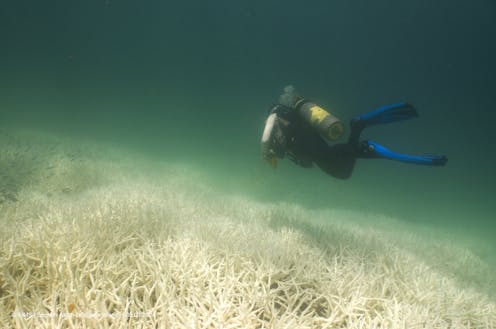Global coral bleaching caused by global warming demands a global response
- Written by Britta Schaffelke, Manager International Partnerships and Co-ordinator of the Global Coral Reef Monitoring Network (GCRMN), Australian Institute of Marine Science

The fourth global coral bleaching event, announced this week, is an urgent wake-up call to the world.
While the US National Oceanographic and Atmospheric Administration’s announcement is not unexpected, it’s the second global mass bleaching in the past decade. It heralds a new reality in which we can expect more frequent and severe bleaching events as ocean temperature records continue to be broken.
Cycles of decline and recovery are normal for coral reefs, but the windows for recovery are now shorter. Stress events such as marine heatwaves are coming faster, with less warning. These events are also more widespread.
The latest global sea surface temperatures remain above long-term averages.
As the southern hemisphere shifts into winter, the northern hemisphere’s tropical oceans enter summer. Heat will start to accumulate, this year from a higher base. Reefs are more likely to be under greater heat stress earlier than in previous years.
What happened last summer?
Widespread mass bleaching is new for coral reefs. The first global bleaching event was in 1998.
Global mass bleaching events are “called” when significant coral bleaching is confirmed in the Atlantic, Indian and Pacific oceans.
The current event is shaping up to be one of the most severe yet. It began as severe heat stress accumulated in the northern hemisphere summer of 2023. It continued into the southern hemisphere summer of 2023–24.
In the past, summer temperatures on the Great Barrier Reef peaked around February. Now, ocean temperatures are higher for longer. We see maximums above historic values well into April.
On the Great Barrier Reef, large areas were exposed to record-breaking heat stress over its summer (December to March). Prevalent bleaching was observed on three-quarters of surveyed coral reefs in shallow water.
The images below show the reef at North Keppel Island in the southern Great Barrier Reef before bleaching in May 2023 and during bleaching in March 2024. (Click on and drag the slider back and forth to see the difference.)
While it is too early to know the full impact, it is shaping up to be one of the most serious and extensive mass bleaching events recorded on the Great Barrier Reef.
Read more: Is the Great Barrier Reef reviving – or dying? Here's what's happening beyond the headlines
Why are coral reefs so important?
Coral reefs are vital for ocean health. They also provide food, income and coastal protection from storms and floods for an estimated 500 million people. They cover less than 1% of the seafloor but support at least 25% of marine species.
Like the polar regions, coral reefs are especially vulnerable to the effects of climate change. Increasing concentrations of greenhouse gases are heating the oceans.
Can reefs recover from this event?
This current global event is still unfolding. Its full impacts will not be known for some time.
Some coral deaths are immediate. Some colonies recover, while others succumb after the ocean heat subsides. Complex local and species-specific differences are typical for the responses of corals to heat stress and their recovery after an event.
Bleaching occurs when corals under severe stress expel the symbiotic algae living in their tissues, causing them to turn completely white. Though not dead, corals are weakened by bleaching. Those that survive are more susceptible to diseases. Bleaching could also impair their capacity to reproduce.
More than 40 years of data analysed by the Global Coral Reef Monitoring Network show a downward trend in the amount of coral on reefs between 2009 and 2018. This coral loss reflects the cumulative impacts of previous coral bleaching events and local pressures such as pollution, destructive coastal development and overfishing.
After the devastating multiyear bleaching event of 2014–17, some reefs regained some of the lost coral cover during low disturbance periods. Most of the gains were by fast-growing “tabular” corals, which may change reefs’ species composition.
Read more: Accelerated evolution and automated aquaculture could help coral weather the heat
An opportunity to learn more about saving reefs
Long-term monitoring identifies areas of coral reefs that recover naturally after a disturbance, and areas that don’t. This information helps reef managers and scientists know where to focus their efforts to assist reef protection and recovery.
At present, this information is often sparse. Monitoring the world’s reefs is challenging. The total global area of shallow-water coral reefs is estimated at 249,713 square kilometres. Many reefs are in remote locations.
Recent monitoring innovations will improve access to quality data in the medium term.
While devastating, mass coral bleaching events provide a unique opportunity for research to inform actions. In Australia and around the world, scientists are studying which corals are the most tolerant of heat, whether corals are adapting to marine heatwaves, why corals recover differently and how to use this knowledge for interventions that can improve reef resilience.
Science that enables actions that mirror the local conditions – both biophysical and socio-economic – will enable interventions to be more locally relevant.
Read more: Sentinels of the sea: ancient boulder corals are key to reef survival in a warmer world
What can we do?
How fast the world acts to reduce the greenhouse gas emissions driving global warming will determine which reefs, marine species and ecosystem functions and services can be maintained.
A multi-pronged approach for protecting and restoring coral reefs has guided many management strategies, plans and calls to action around the world. These have been largely focused on local and regional actions and solutions. In Australia, there has been significant investment in water-quality management and in research and development of coral reef restoration techniques.
Science plays an important role here. Ideas are cheap but implementation is difficult and expensive. Effective global collaborations can find more cost-effective solutions to improve reef resilience.
Tackling local factors that affect the health of coral reefs remains important, as are innovations to protect and restore coral reefs. But, above all, urgent action to curb the effects of global climate change is vital for the health of our oceans and the people who depend on marine resources.
Authors: Britta Schaffelke, Manager International Partnerships and Co-ordinator of the Global Coral Reef Monitoring Network (GCRMN), Australian Institute of Marine Science



















